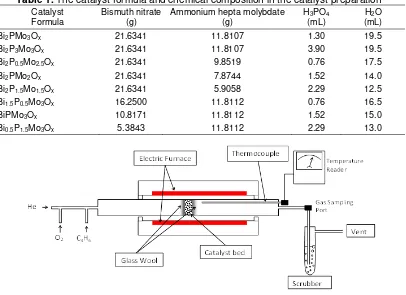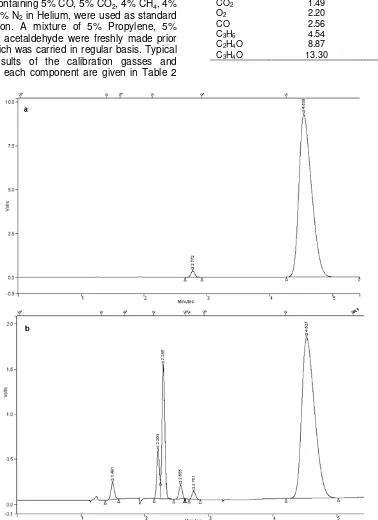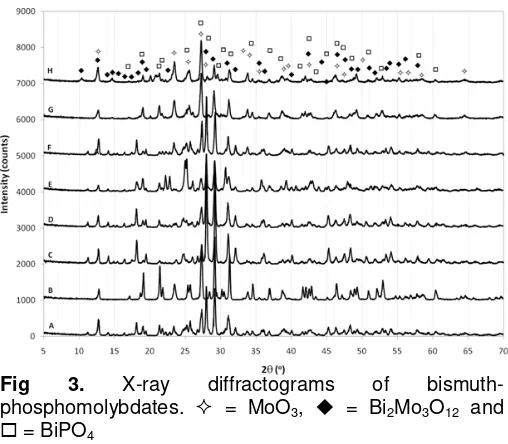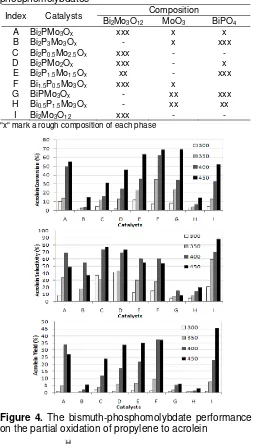THE EFFECT OF PHOSPHORUS ADDITION ON THE ACTIVITY OF BISMUTH MOLYBDATE
CATALYST FOR PARTIAL OXIDATION OF PROPYLENE TO ACROLEIN
Hamzah Fansuri1,*, Gia Hung Pham2, Sandra Wibawanta2, and Dong-ke Zhang3
1
Department of Chemistry, Institut Teknologi Sepuluh Nopember (ITS), Kampus ITS Sukolilo, Surabaya 60111 2Department of Chemical Engineering, Curtin University of Technology, Kent St Bentley WA 6102,Australia
3
UWA Centre for Energy, University of Western Australia, 35 Stirling Highway, Crawley WA 6009,Australia
Received March 31, 2010; Accepted August 27, 2010
ABSTRACT
In order to examine the effect of phosphorus addition on the activity and selectivity of bismuth molybdate catalysts for partial oxidation of propylene to acrolein, three modes of phosphorus addition were performed. The three modes of Preparation were performed by (1) adding phosphorus into α-Bi2Mo3O12 to obtain Bi2PxMo3Oy, (2)
inserting phosphorus on bismuth sites to obtain Bi2-xPxMo3Oy, and (3) inserting phosphorus on molybdenum sites to
obtain Bi2PxMo3-xOy. Four major phases of bismuth phosphomolybdate were detected as the result of the
phosphorus addition, namely α-Bi2Mo3O12, Bi9PMo12O52, MoO3, and BiPO4. Experimental results showed that the
catalysts solely containing BiPO4 and/or MoO3 have very low activities for partial oxidation of propylene to acrolein.
Meanwhile, catalysts containing α-Bi2Mo3O12 and Bi9PMo12O52, together with either MoO3 or BiPO4 showed on
average the same activities as α-Bi2Mo3O12 and one of them (combination of α-Bi2Mo3O12, Bi9PMo12O52 and MoO3)
has better performance than α-Bi2Mo3O12 at lower temperatures. The presence of the oxygen donor phase, i.e.
BiPO4 and MoO3, are believed to play a key role for the high activities of bismuth-phosphomolybdate catalysts.
However, at higher temperatures, the presence of oxygen donor reduces the catalyst selectivity to acrolein.
Keywords: Propylene, Acrolein, Bismuth Molybdate, Partial oxidation
INTRODUCTION
Phosphorus has long been used as an additive for bismuth molybdate catalysts for propylene to acrolein conversion. The first phosphorus containing bismuth molybdate catalyst for this purpose was developed by
Sohio in 1957 in the form of Bi9PMo12O52 supported on
SiO2 [1]. Since then, phosphorus has become an
essential additive for bismuth molybdate-based commercial catalysts.
There are numerous reports on the role of phosphorus in bismuth molybdate catalysts for selective oxidation of hydrocarbon. Chang et al. [2] reported that phosphorus additive increases the acidity of molybdate
leading to promotion of O2- as the product of O2
dissociation. The increased acid/base ratio in phosphorus added bismuth molybdate catalysts was also reported by Kaddouri et al. [3].
The increase in acidity of bismuth molybdate catalysts plays an important role in enhancing the catalyst activity because the acid site is the place where the hydrocarbon species were adsorbed by the catalyst. The acid sites, then, capture one hydrogen atom from the gaseous reactant to produce, in the case of propylene partial oxidation, allyl groups. This process is believed to be the rate-determining step in the partial
oxidation of propylene to acrolein over the bismuth molybdate catalysts [4-7].
Meanwhile, Qiu et al. [8] reported that the
phosphorus additive in the form of BiPO4 improved the
performance of ZnFe2O4 catalyst for butene
dehydrogenation to butadiene. They found that BiPO4
protects the catalysts against deactivation, which was then proved by Weng and co-workers in 1992 [9].
In our previous work, we reported that the action
of bismuth molybdate catalysts (α-Bi2Mo3O12,
b-Bi2Mo2O9, and g-Bi2MoO6) in catalysing selective partial
oxidation of propylene to acrolein was influenced by their lattice oxygen [10]. This paper discusses the effect of phosphorus addition in alpha-Bismuth
molybdate (α-Bi2Mo3O12) and its effect on the catalyst
activities and selectivities to the formation of acrolein from propylene.
EXPERIMENTAL SECTION
Materials
All chemicals used in this research are analytical grade. The source of bismuth, molybdenum and
phosphorous were Bi(NO3)3.5H2O, (NH4)6Mo7O24.4H2O
and H3PO4, respectively. All gasses were High Purity (HP)
* Corresponding author. Tel/Fax : +62-31-5943353/5928314 Email address : [email protected]
Table 1. The catalyst formula and chemical composition in the catalyst preparation
Catalyst
Formula Bismuth nitrate (g) Ammonium hepta molybdate (g) H(mL) 3PO4 (mL) H2O
Bi2PMo3Ox 21.6341 11.8107 1.30 19.5
Bi2P3Mo3Ox 21.6341 11.8107 3.90 19.5
Bi2P0.5Mo2.5Ox 21.6341 9.8519 0.76 17.5
Bi2PMo2Ox 21.6341 7.8744 1.52 14.0
Bi2P1.5Mo1.5Ox 21.6341 5.9058 2.29 12.5
Bi1.5P0.5Mo3Ox 16.2500 11.8112 0.76 16.5
BiPMo3Ox 10.8171 11.8112 1.52 15.0
Bi0.5P1.5Mo3Ox 5.3843 11.8112 2.29 13.0
Fig 1. Schematic of the reactor configuration for catalyst activity scanning (Adapted from [10])
grade from BOC gas, Australia. Micromat-14TM (Grace,
Cat. No. 19792) was used as standard gas for GC calibration.
Instrumentation
A Siemens D500 X-ray Diffractometer was used in all diffraction analysis. Meanwhile, A Varian 3400 CX Gas Chromatography was used to analyse gas composition.
Procedure
Catalyst Preparation and Characterisation
The catalysts were prepared using the so-called co-precipitation method based on the preparation of
α-Bi2Mo3O12 [10]. Powders of Bi(NO3)3.5H2O and
(NH4)6Mo7O24.4H2O were dissolved separately in warm
water (70 °C). Phosphoric acid, H3PO4, was then added
into the bismuthyl nitrate solution. The mixture was dropped slowly into the vigorously stirred ammonium hepta-molybdate solution, producing a yellowish suspension. The suspension was kept in the water bath at 70 °C and stirred well to evaporate the liquid slowly until it became a paste. The paste was then put into an oven at 120 °C for 20 h in air. The dried cake, that was formed, was crushed and heated at 250 °C for 2 h in an
air oven. The catalyst was then ground to powder and calcined for 20 h at 480 °C. The final catalysts formula and the composition of the ingredients in the catalyst preparation are listed in Table 1.
All catalysts were characterised by X-ray diffraction using Cu Kα source without any filter. The diffractograms were taken from 5° to 70° (2θ), step size
0.02°, and scan speed 2.4°min-1. The phase analysis
was carried out by JADE ver. 6.0 software available at Applied Physics Department, Curtin University of Technology.
Activity and Selectivity tests
Catalyst activity was measured in a single pass fixed-bed stainless steel reactor (10mm ID). The catalyst powder (ca 1.9 g) was sandwiched between two glass wool pads in the reactor. A type J thermocouple was fitted at the end of the catalyst bed. The outlet of the reactor was connected to a scrubber, which contains a sodium hydroxide solution with pH 11 to convert all acrolein being produced to polyacrolein, preventing the harmful acrolein from being released to the environment. The arrangement of the reactor is given in Fig. 1.
The feed gases used were industrial-grade O2, high
purity He, and polymer-grade propylene from BOC Australia without further purification. The total flow-rate
Hamzah Fansuri et al.
was 120 cm3 min-1. The flow-rate was regulated with
three MKS mass-flow controllers. The composition of the
reactant gas was set to 85% He, 10% O2 and 5% C3H6.
A gas chromatograph was used to analyse gas composition of the reactant and product streams. The GC was fitted with a molecular sieve in series with a Porapak N and equipped with a TCD and FID detectors.
Micromat-14TM containing 5% CO, 5% CO
2, 4% CH4, 4%
H2, 5% O2 and 5% N2 in Helium, were used as standard
gas for calibration. A mixture of 5% Propylene, 5% acrolein and 5% acetaldehyde were freshly made prior to calibration which was carried in regular basis. Typical GC analysis results of the calibration gasses and retention time of each component are given in Table 2 and Fig. 2.
The gas analysis results were then used to calculate propylene conversion (X), acrolein selectivity (S) and acrolein yield (Y) which was defined in Equations 1–3.
Table 2. The retention time of reactants and products
of activity-selectivity analysis using the GC method Component Retention time (min) Detector
CO2 1.49 TCD
O2 2.20 TCD
CO 2.56 TCD
C3H6 4.54 FID
C2H4O 8.87 FID
C3H4O 13.30 FID
Hamzah Fansuri et al.
Fig 3. X-ray diffractograms of
bismuth-phosphomolybdates. = MoO3, = Bi2Mo3O12 and
= BiPO4
Table 3. Symmetry and cell parameters of phases found
from the diffraction analysis
Cell Parameters α-Bi2Mo3O12 MoO3 BiPO4
The performance of all bismuth phospho-molybdate catalysts was compared to the performance
of α-Bi2Mo3O12 from our previous work [11].
RESULT AND DISCUSSION
Fig. 3 shows the XRD patterns obtained for the bismuth-phosphomolybdate catalysts on which major phases are marked. There are three major phases found
from the XRD analysis, namely α-Bi2Mo3O12, MoO3 and
BiPO4 in the catalysts. Symmetry and cell parameters of
each phase are given in Table 3. No evident is found on
the formation of phosphorous substituted α-Bi2Mo3O12
from the diffraction patterns. If the phase exist, it crystal size might be too small or the concentration is too low so X-ray diffraction can not detect it. Other phase of
bismuth molybdates such as β-Bi2Mo2O9 and
γ-Bi2MoO6, and Bi2O3 might also be formed as there are
several peaks on the diffractograms which can not be identified due to their very low intensities.
The unit cell of α-Bi2Mo3O12 is closely resembles
van den Elzen and Rieck [12] model with slightly larger unit cell volume. The slight difference of the prepared structure with the van den Elzen model is believed to be caused by different preparation method. The structure of van den Elzen model was derived from the single crystalline form of alpha bismuth molybdate. Crystallisation of alpha phase has to be carried out at high temperature, i.e. at its melting point (670 °C). In contrast, the powder form in this report was prepared at low temperature (480 °C). As a result, the powder structure is more relaxed than the single crystalline one and thus resulting larger unit cell volume.
Crystal structure of MoO3 is indexed to
orthorhombic phase (JC-PDF2 Card No. 05-0508). The structure resembles those reported by Galy et al. [13].
In this structure, Mo6+ ion is surrounded by oxygen
atoms in the form of distorted octahedral symmetry. The octahedra associate by edge-sharing along [010]
to form (MoO3)n double layers.
BiPO4 crystal structure can be indexed to the
monoclinic phase (JC-PDF2 Card No. 15-0767) rather than the low temperature, hexagonal phase (JC-PDF2 Card No. 15-0766). The structure is similar to those reported by Xue et al. [14] for nano-cocoons and
nanorods BiPO4, prepared by solvothermal method.
The results of diffraction analysis do not show any
Bi9PMo12O52 phase which, according to the literature
[1], is the most active phase of bismuth lyst. According to the empirical
formulae, Bi9PMo12O52 shall contain a combination
between BiO+ and phosphomolybdate ions as in the
heteropolyacid P2O5.24MoO3.30H2O. The combination
is resulting a very good acid catalyst that can enhance the activity of bismuth molybdate catalyst when both phases are coexisted. However, Batist et al. [15]
revealed that Bi9PMo12O52 was actually a mixture
between BiPO4 and α-Bi2Mo3O12. Therefore, the
catalyst that contains both BiPO4 and α-Bi2Mo3O12 will
have higher activity than those that do not contain both phase.
phosphomolybdate cata
Phase distribution of α -Bi2Mo3O12, MoO3, and
BiPO4 depends on the composition of bismuth,
molybdenum and phosphorous in the reaction mixture. Table 4 shows the distribution of the phases among the bismuth-phophomolybdates based on their X-ray diffraction’s Relative Intensity Ratio (RIR). The results reveal that the ratio of Bi:P:Mo determines which phases will be formed in the catalyst preparation. The table also shows that the main products from the
Hamzah Fansuri et al.
Table 4.The phase composition of all
bismuth-phosphomolybdates
Index Catalysts Bi Composition
2Mo3O12 MoO3 BiPO4
"x" mark a rough composition of each phase
Figure 4. The bismuth-phosphomolybdate performance
on the partial oxidation of propylene to acrolein
Fig 5. Allyl formation on bismuth-phosphomolybdate
catalyst. a) Hydrogen ion is captured by a carbonyl oxygen and b) Hydrogen ion is captured by the bridge oxygen [18]
is detected when the ratio of Bi:P≥0.5. At lower ratio, the phase is not detected may be due to its very low
concentration or poor crystallinity. MoO3 is more likely
to be formed if there are elements not reacted to form α-Bi2Mo3O12 or BiPO4.
Study on the catalyst activity and selectivity on the conversion of propylene to acrolein shows that the phase composition of each bismuth phosphomolybdate seems to have little effects. Fig. 4 shows the propylene conversion, selectivity of acrolein, and acrolein yields as a function of the catalyst phase composition.
Catalysts α-Bi2Mo3O12 in its mixture with BiPO4
and MoO3 exhibit a higher activity and selectivity than
the mixture of just BiPO4 and MoO3. The catalysts,
which only consist of BiPO4 and MoO3 (catalyst B, G
and H), have a very poor activity to the formation of acrolein from propylene.
The low activity of the catalysts consisting of only
BiPO4 and MoO3 is consistent with those reported in
literatures [16-17]. According to the literatures, there are two steps involved in the partial oxidation of propylene to acrolein, i.e., allyl formation and oxygen insertion. The allyl formation, as depicted by Fig. 5, requires the existence of bismuth-oxide groups on the catalyst surface while the Mo-O groups supply the oxygen to oxidise the allyl. Catalyst B, G and H do not have a bismuth oxide group adjacent to molybdenum oxide to facilitate those activation reactions. Due to this reason, the absence of Bi-O groups in catalysts B, G and H is believed as the major cause of the poor activities of those catalysts, although one of them (catalyst G) showed a high conversion of propylene.
An interesting trend of activities is shown by catalysts C, D, E and F. Fig. 3 shows that the catalysts,
which contain Bi2Mo3O12 and Bi9PMo12O52, are more
active than those which do not contain them. Based on
this information, the coexistence of Bi2Mo3O12 together
with Bi9PMo12O52 is most probably a factor responsible
for the high activities of catalysts C, D, E, and F. Fig. 3 and Table 2 also shows the influence of coexistence of
a third additive, namely MoO3 or BiPO4. The existence
of both phases makes the catalysts D, E, and F have higher activity than catalysts C.
All above information proves that both BiPO4 and
MoO3, although on their own have very low activity
toward the acrolein formation, are able to improve the
activity of the main catalysts (Bi2MO3O12 and
Bi9PMo12O52). Some literature believes that either
MoO3 or BiPO4 improves the catalyst activity by acting
as an oxygen source for rapid re-oxidation of the active
site [8,16-17,19]. The MoO3 provides oxygen for the
reaction by reducing the oxidation number of Mo6+, to
Mo5+ and/or Mo4+. On the other hand, phosphorus has
Hamzah Fansuri et al.
phosphorus oxide, which has a pπ-pπ bond between phosphorus and oxygen, to easily donate its oxygen for the reaction. Phosphorus could also perform multiple bonding and, as a result, improve the stability of the complexes with transition elements in the catalysts [20].
CONCLUSION
Phosphorus addition in the preparation of
α-Bi2Mo3O12 precursor produced four major phases of
bismuth phosphomolybdate under the preparation condition mentioned in the experimental method, namely
α-Bi2Mo3O12, Bi9PMo12O52, MoO3, and BiPO4. The BiPO4
was formed when the Bi:P ≥ 0.5 while other phases will be formed if there were elements not reacted to form
either α-Bi2Mo3O12 or BiPO4. The catalysts activity and
selectivity test show that those that solely containing
BiPO4 and MoO3 have very low activities for partial
oxidation of propylene to acrolein. Meanwhile, catalysts
containing α-Bi2Mo3O12 and Bi9PMo12O52, together with
either MoO3 or BiPO4 showed on average the same
activities as α-Bi2Mo3O12. One of the catalysts which
contain a combination of α-Bi2Mo3O12, Bi9PMo12O52 and
MoO3 has even better performance than α-Bi2Mo3O12 at
lower temperatures. The presence of the oxygen donor
phase, i.e. BiPO4 and MoO3, are believed to play a key
role for the high activities of bismuth-phosphomolybdate catalysts. However, at higher temperatures, the presence of the oxygen donor reduces the catalyst selectivity to acrolein.
ACKNOWLEDGEMENT
The writing of this manuscript was funded by Indonesian Ministry of Education under 2009 PAR-B project.
REFERENCES
1. Ohara, T., Sato, T., and Shimizu, N., 2000, “Acrolein
and Methacrolein”, in Handbook of Commercial
Catalysis: Heterogeneous Catalysts, ed. Rase, H.F., CRC Press, Boca Raton.
2. Chang, T.-S., Cho, D.-H., Lee, D.-K., and Yun,
S.-S., 2001, Bull. Korean Chem. Soc., 22, 1, 117–119.
3. Kaddouri, A., Mazzocchia, C., and Tempesti, E.,
1999, Appl. Catal., A, 180, 1-2, 271–275.
10. Fansuri, H., Pham, G.H., Wibawanta, S., Radford,
R., and Zhang, D.K., 2004, Dev. Chem. Eng.
Miner. Process., 12, 3-4, 333–340.
11. Fansuri, H., 2005, Catalytic Partial Oxidation of
Propylene to Acrolein: The Catalyst Structure,
Reaction Mechanisms and Kinetics, PhD Thesis,
Department of Chemical Engineering, Curtin University of Technology, Perth, Australia.
12. Ono, T., Utsumi, K., Kataoka, M., Tanaka, Y., and
Noguchi, F., 2004, Catal. Today, 91-92, 181–184.
13. Galy, J., Ratusznac, A., Iglesias, J.E., and Castroa,
A., 2006, Solid State Sci., 8, 1438–1442.
14. Xue, F., Li, H., Zhu, Y., Xiong, S., Zhang, X.,
Wang, T., Liang, X., and Qian, Y., 2009, J. Solid
State Chem., 182, 1396–1400.
15. Batist, Ph. A., Bouwens, J.F.H., and Matsuura, I.,
1974, J. Catal., 32, 362–368.
16. Wang, Y., Zheng, W., and Chen, F, 2008, Appl.
Catal. A, 351, 1, 75–81.
17. Zhao, C., and Wachs, I.E., 2006, Catal. Today,
118, 3-4, 332–343.
18. Fansuri, H., Pham, G.H., Wibawanta, S., French,
D., and Zhang, D.K., 2003, Surf. Rev. Lett., 10, 2-3,
549–553.
19. Qiu, F.-Y., Weng, L.-T., Ruiz, P., and Delmon, B.,
1989, Appl. Catal., 47, 115–123.
20. Scheer, M., Schiffer, M., Leiner, E., Johnson, B.P.,
Haindl, C., and Umbarkar, S., 2002, Phosphorus,



